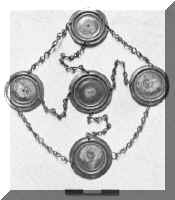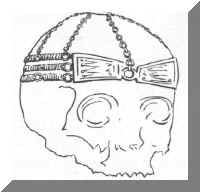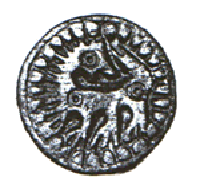The Cavenham Crowns
Discovered in the early 20th Century, these exceptional pieces, thought to be
Roman and dating from the 2nd Century AD, are now on display in Ipswich Museum.
There are two bronze crowns and an ornament of chains and discs that would have
been used as a headdress. The three items are thought to be have been used in
some form of pagan ritual, probably being worn by priests.
The crowns would originally have been adorned by silver decorative plaques.
The larger of the two is fitted with metal loops which would have supported some
additional ornamentation, thought to be bronze feathers, an example of such
having been excavated nearby. It also features a lace-like design along its
edge. Interestingly, both crowns are adjustable, to accommodate differing head
sizes.

The bronze chain headdress consists of five bronze disc joined together by
eight metal chains, formed of S-shaped
links, designed to fit the head, possibly being worn over a leather cap. The
slightly larger, central disc would have been worn on top of the head, with the
other four being positioned on the forehead, at the back of the head and one
over each ear.


Other finds
Specimen tiles and fragments of pottery also taken from the site were
identified by Mr. Wright of Colchester Museum and dated from the 1st to 3rd or
4th century A.D. While a later dig identified a very large urn whose mouth
measured 131/2 inches and dated 40 to 80 A.D. and ‘brown -leather’ ware was
dated 1 to 50 A.D. Though no villa was found within a 30 yard radius it is
considered likely that Roman dwellings did exist .
.
The source of this report; Miss Nina Laylard obtained the items in 1918 from
the landlord of The Crown Inn at Mumford and in the face of much doubt set out
to discover their origins. With Reginald Smith, Miss Layland tracked down the
original findspot, and excavations further demonstrated a Roman archaeological
context, by 1924 academic opinion agreed with her conclusions.
 Illustration;
Reported to be found in Cavenham this ‘animal’ brooche measuring 1.2”
diameter and 0.6” thick is now held in the Clouston Collection (No786)
Illustration;
Reported to be found in Cavenham this ‘animal’ brooche measuring 1.2”
diameter and 0.6” thick is now held in the Clouston Collection (No786)
©2000 Juliana Unicke and Sarah Brownie